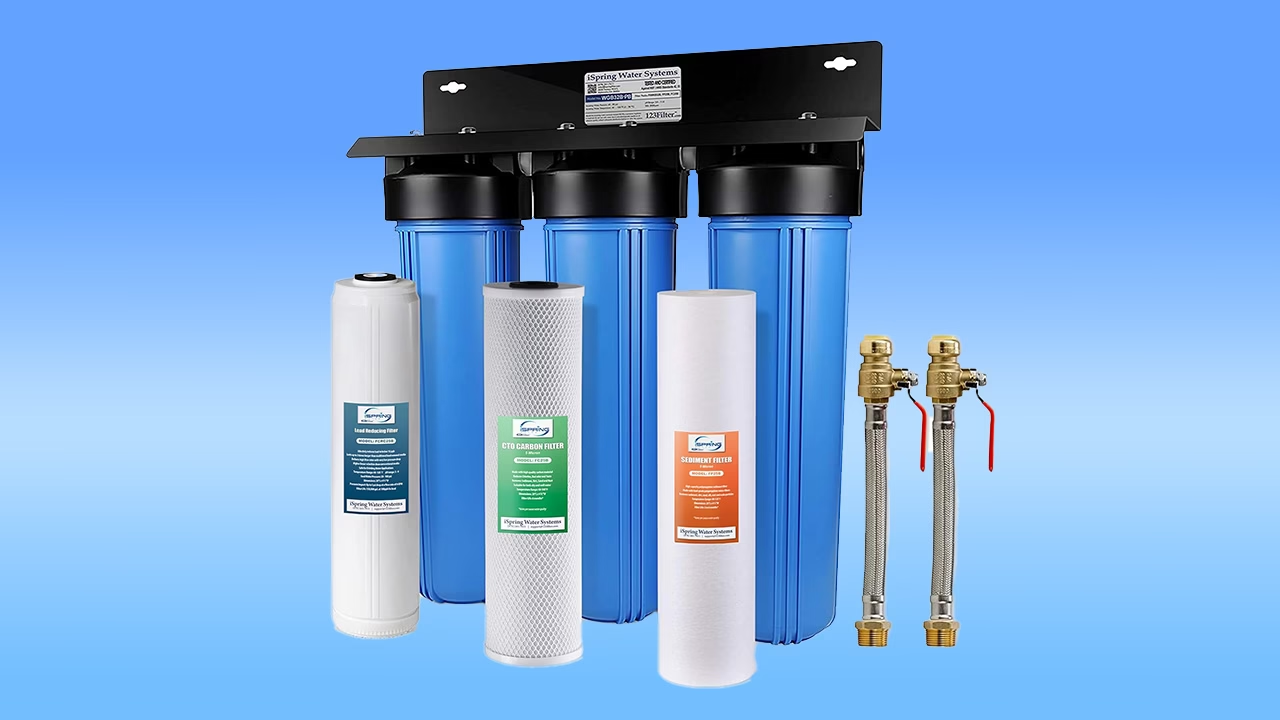iSpring water filter review: Honest WGB32B-PB analysis — installation, performance, costs, pros/cons to help you decide.
Table of Contents
Introduction
This review looks at the iSpring water filter (WGB32B-PB). It is a 3-stage system for your whole house. I will cover how it works, how to install it, how well it performs, what it costs, and who should buy it. My goal is to give you a clear and helpful guide. This will help you decide if this filter is right for your home and budget.
[Amazon Affiliate Disclaimer: If you decide to purchase a product through a link on the site, I may earn a commission without additional cost to you. Learn more Here]
Quick Overview: What It Is and Who It’s For
The iSpring WGB32B-PB is a 3-stage water filter for your whole house.
- It has a sediment filter, a carbon block filter, and a special lead filter.
- It removes things like chlorine, dirt, some chemicals, and lead from city water.
- It uses big, standard cartridges.
- It allows a good flow of water for the whole home.
This system is best for people on city water. It helps get rid of the taste and smell of chlorine. It also lowers lead and other chemicals. It does not remove healthy minerals from the water.
It is not for well water with serious problems. It is also not for water with very high mineral content. For those, you need special systems.
NOTE: If you have hard water, consider pairing this filter with a water softener; learn more about the difference between a filter and a softener here.
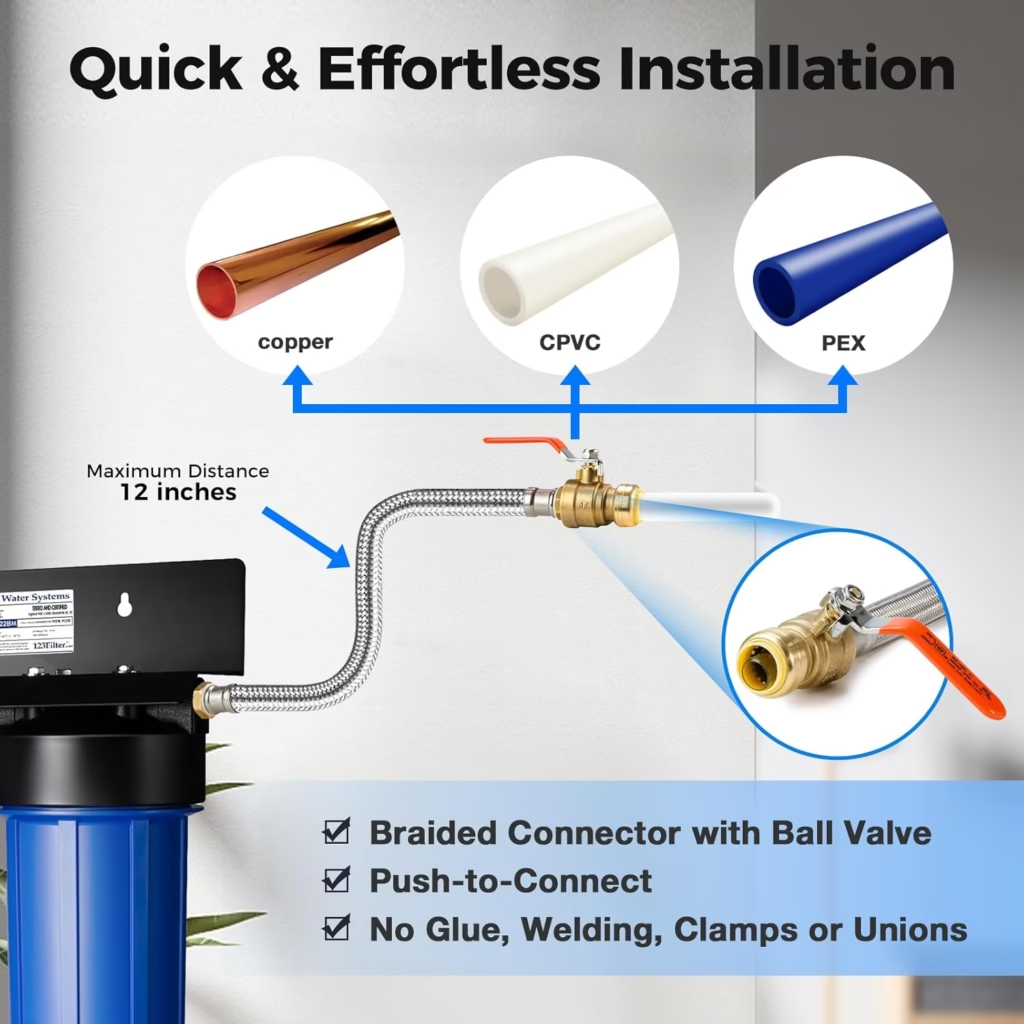
Key Specs and What They Mean
- Model: iSpring WGB32B-PB (3-Stage Whole House Water Filtration System).
- Cartridge Size: Uses big, standard 20-inch cartridges.
- Stages: 1. Sediment Filter, 2. Carbon Block Filter, 3. Lead Filter.
- Capacity: Filters last a long time, up to 100,000 gallons or more for some stages.
- Flow Rate: Good water flow for the whole house.
- Connection Size: Standard 1-inch pipe connections.
- Certifications: Tested to meet industry standards.
- Warranty: Comes with a one-year warranty.
These specs mean it’s good for families. It treats all the water in your house without slowing the water pressure much. It targets chlorine, dirt, and lead.
Filtration Stages: What Each Stage Does
Stage 1: Sediment Filter
This is the first stage. It catches sand, rust, and dirt. This protects the other filters. It helps all the filters last longer.
Stage 2: Carbon Block Filter
This is the second stage. It uses carbon made from coconut shells. It reduces chlorine, bad tastes, and smells. It also removes some chemicals.
Stage 3: Lead-Reducing Filter
This is the third stage. It is made to target lead and some other metals. It lowers lead to safe levels. This is important for homes with old pipes.
Performance: Lab Claims vs Real-World Use
Contaminant Reduction and Testing
The company says the filters are tested. They are proven to reduce chlorine, dirt, and lead. In real life:
- The chlorine taste and smell go away quickly.
- Lead is reduced, but you must change the filter on time.
- It does not remove dissolved minerals. So, it will not make soft water.
Flow Rate and Pressure
The system is built for good water flow. You can run a shower and a washing machine at the same time. Most users see very little drop in water pressure.
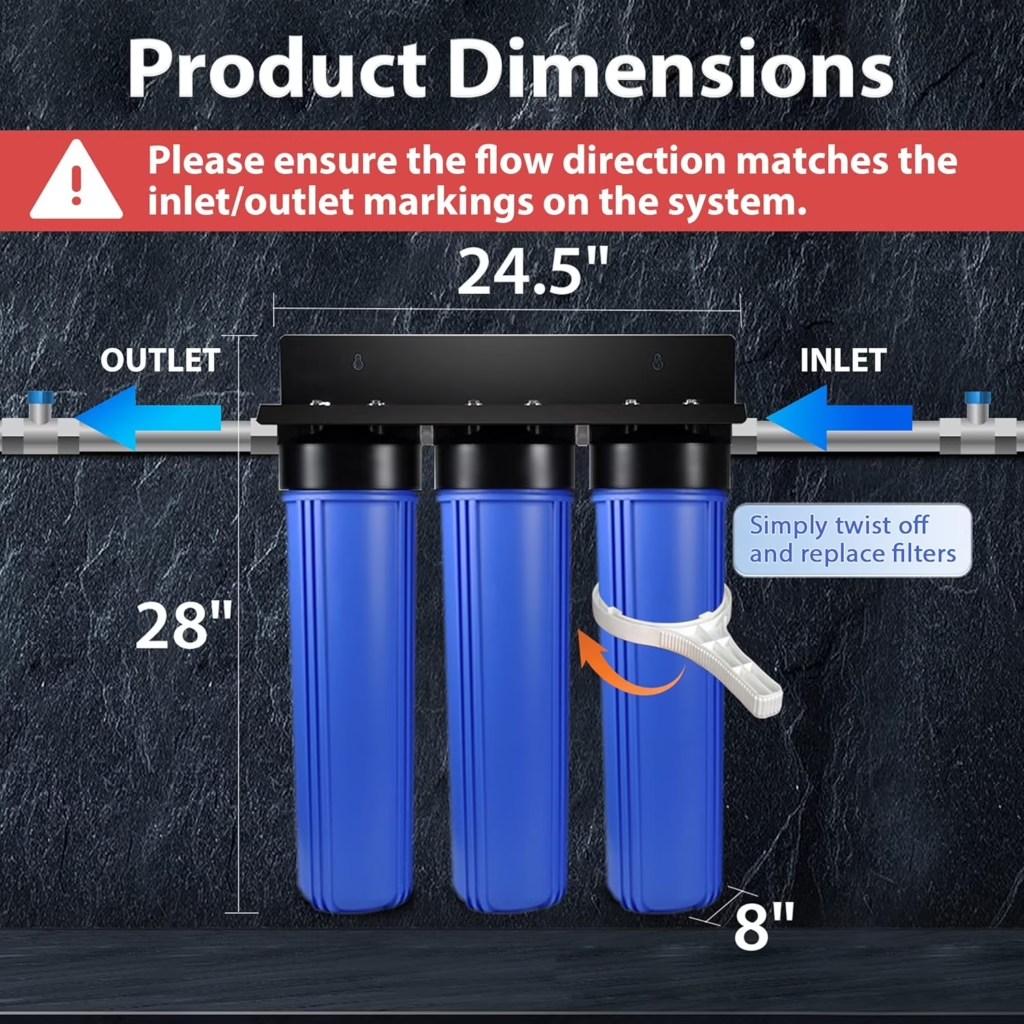
Installation and DIY Guide
What’s in the Box and Checks Before You Start
The box has the three filter housings, the three filters, a bracket, and a wrench. iSpring gives you a guide and videos to help.
Before you start:
- Check your pipe size.
- Make sure you have enough space to change the big filters.
- It’s a good idea to add a bypass valve. This lets you change filters without turning off all the water.
Basic DIY Installation Steps
- Turn off the main water supply.
- Pick a spot near where the water enters your house. Attach the bracket to the wall.
- Install the three filter housings in the right order. Connect the pipes.
- Add a bypass valve if you can.
- Turn the water back on. Check for leaks. Flush the filters as the instructions say.
- Test your water at different taps.
If you know basic plumbing, you can likely install this yourself. If not, you may want to hire a plumber.
Maintenance and Costs
Filter Life and Replacement
- Sediment Filter: Lasts a few months. Check it every 3-6 months.
- Carbon Block Filter: Usually lasts about a year.
- Lead Filter: Replace it once a year, or as the manual says.
How often you change them depends on your water. It’s smart to keep spare filters at home. For full maintenance guide, please see here.
Cost of Ownership
You pay for the system first. Then you pay for new filter sets each year. The total yearly cost for filters is a few hundred dollars. This is often less than more complex systems.
User Feedback: The Good and The Bad
What People Like
- Water tastes better and smells less like chlorine.
- Water pressure stays strong.
- Easy to change the filters.
- The lead filter gives peace of mind.
Common Complaints
- It does not soften hard water.
- Filter life can be short if your water has a lot of dirt or rust.
- If installed wrong, water pressure can drop.
- It does not remove all contaminants (like nitrates or bacteria).
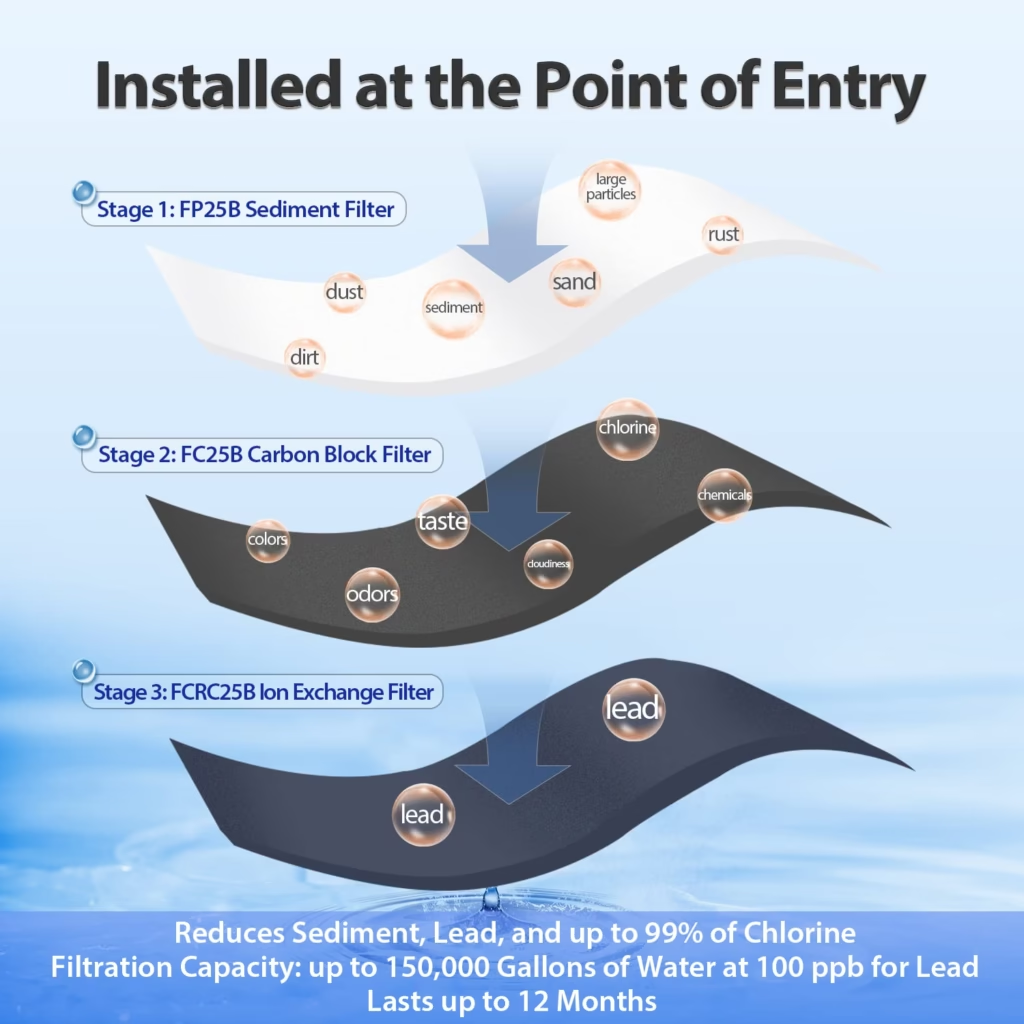
How It Compares to Other Filters
Vs. Single-Stage Filters
This system does more. It removes dirt, chlorine, AND lead. A single-stage filter only does one of those things.
Vs. Under-Sink Lead Filters
An under-sink filter only cleans water at one faucet. This iSpring system cleans the water at every tap in your house.
Vs. Reverse Osmosis (RO) Systems
RO systems remove almost everything from water, including healthy minerals. But they are usually for one faucet and waste some water. This iSpring system keeps healthy minerals and treats all the water in your house.
Vs. Water Softeners
A softener removes minerals that make water hard. It does not remove chlorine or lead. If you have hard water and city chemicals, you might need both a filter and a softener.
Installation Tips and Best Practices
- If your water has lots of dirt, add a pre-filter. This will make your main filters last longer.
- Install a bypass valve. This makes filter changes much easier.
- Mount the unit on a strong wall with plenty of room to work.
- Test your water before and after you install the system.
Who Should Buy This Filter?
- Families on city water who want to reduce chlorine, bad taste, and lead.
- People who want to treat all the water in their home.
- Those who want a good system that is easy to maintain.
- DIYers who are okay with basic plumbing.
Who Should Not Buy This Filter?
- Homes with very hard water (you will need a softener too).
- Homes with well water that has bacteria or other serious issues.
- People who want water with no minerals at all (you would need an RO system for your drinking water).
Pros and Cons Summary
Pros
- Removes dirt, chlorine, and lead from city water.
- Good water flow for the whole house.
- Uses common, easy-to-find filters.
- Most people can install it themselves.
- Keeps healthy minerals in the water.
Cons
- Does not soften water or remove dissolved minerals.
- Filters may need changing more often if your water is dirty.
- The unit is big and needs space to install.
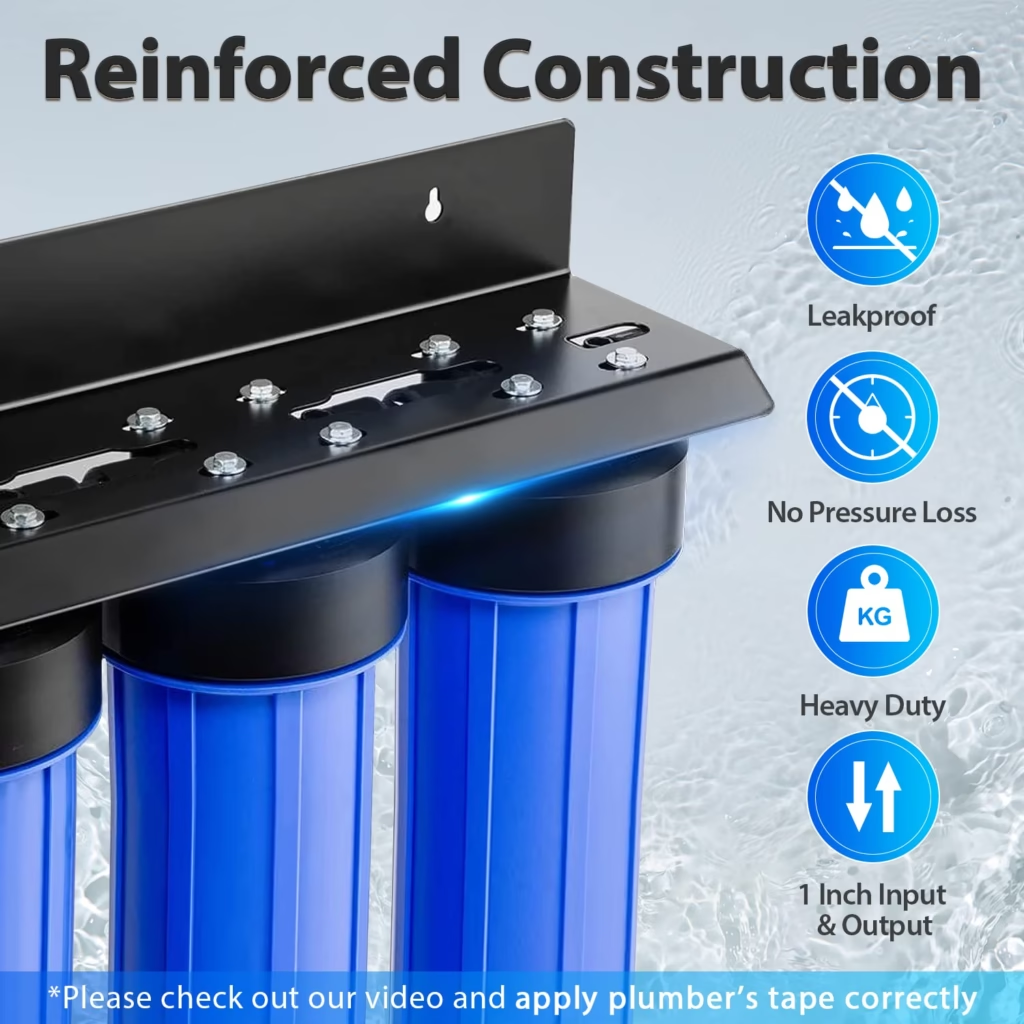
Price and Value: Is It Worth It?
This filter is a mid-range price for a whole-house system. It offers good value. The cost to buy it and the yearly filter cost are fair. It is cheaper than many complex systems.
It is a cost-effective choice if chlorine and lead are your main worries. If you need to soften water or remove other things, you will need more systems, which costs more.
Final Verdict: Should You Buy It?
If you have city water and want to reduce dirt, chlorine, and lead in your whole house, this is a great choice. It works well and doesn’t cost too much.
You can add an under-sink RO system at your kitchen faucet for drinking water with no minerals. If you have hard water, you can add a softener.
Do not buy this if you have well water with germs or very high mineral content. You will need a different solution for those problems.
Also Read: Whole House Salt-Free Water Softener: Top Picks & Buying Guide (2025)
Buying Checklist
- Check your water source (city or well).
- Test your water for lead, chlorine, and hardness if you can.
- Measure your space to make sure the unit will fit.
- Plan to add a bypass valve.
- Decide if you will install it yourself or hire a plumber.
- Think about adding a softener or RO system if you need one.
Frequently Asked Questions (FAQ)
Will this filter soften my water?
No. It removes dirt, chlorine, and lead. It does not remove the minerals that make water hard.
How often do I change the filters?
It depends on your water use and quality. Change the sediment filter every few months. Change the carbon and lead filters about once a year.
Can I install it myself?
Yes, many people do. iSpring provides instructions and videos. If you are not good with plumbing, hire a plumber.
Does it remove bacteria and viruses?
No. It is not made to remove germs. If you have bacteria in your water, you need a UV light or other special treatment.
Is it NSF certified?
The company says the filters are tested to meet industry standards. Check the product page for the exact certification details.
Conclusion
The iSpring WGB32B-PB is a reliable and practical whole-house water filter. It is perfect for city water users. It reduces dirt, chlorine, and lead without slowing your water pressure. It keeps healthy minerals in the water.
It is easy to install and the filters are easy to find. But it does not soften water. It is not for well water with germs. If you need those things, plan to add other systems. For many homes, this iSpring filter is a very good choice.

